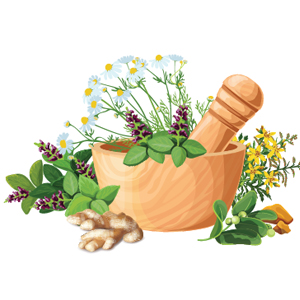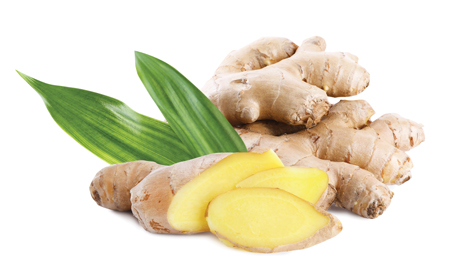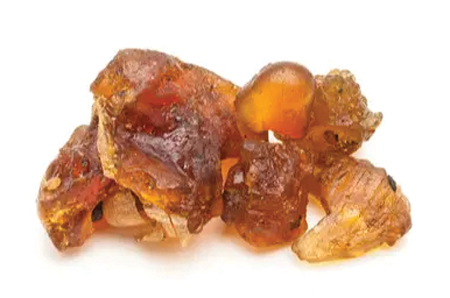Ayurvedic Herbs to Lower Inflammation

This pervasive condition is the bane of our times and the root cause of numerous chronic diseases. But here are five herbs known for their amazing anti-inflammatory properties that will help you fight back.
I am sure we have all heard the health buzzword, “inflammation.” It’s the root cause of numerous autoimmune and degenerative diseases from arthritis to cancer. But what exactly is meant by this treacherous word, “inflammation”?
In a healthy body, the immune system makes antibodies fight off the inflammation caused by bacteria and viruses in case of an infection. It is when the system goes haywire and continues this anti-inflammatory response even in the absence of any outside danger that we have what is referred to as “chronic inflammation,” a serious condition. For example, in rheumatoid arthritis, which is an autoimmune and inflammatory disease, the immune system (mistakenly) starts to attack healthy cells. This can lead to painful swelling in the affected parts of the body and is not limited to joints.
Ayurveda and inflammation
Inflammation is often considered a pitta dosha imbalance in Ayurveda, especially the fire element. But we can’t over-simplify healing, no? From cold and cough to rheumatoid arthritis to cancer, they can’t all be looked at through the same lens of “cooling down pitta.” That’s why here are five promising Ayurvedic herbs that can help lower inflammation within the context of a specific disease. It’s important to note that taking these helpful herbs should not mean stopping your prescribed medication.
Turmeric: Curcuma longa

As a pain reliever, Curcuma longa is potent in treating every aspect of inflammation. It helps with healing, lowers inflammation, is potent for immune health, and supports joint health. Turmeric is a skin rejuvenator and powerful for inflammatory conditions of the skin. Curcumin, a yellow coloring agent extracted from turmeric, shows strong anti-oxidative and antiinflammatory activities when used as a remedy for the prevention and treatment of chronic diseases. It has been used for centuries as a treatment for inflammatory diseases.
Cooking with dried, root turmeric powder is recommended as turmeric is best absorbed when taken with food. A quarter to a half teaspoon per day is safe for most people.
Ginger: Zingiber officinale
 The anti-inflammatory properties of ginger have been known and valued for centuries, at least in South Asian families. Sinus infections can be due to inflammation. All Indian grandmas and mothers use ginger in their cooking to keep the family healthy— from digestive health to battling colds and coughs to lowering aches and pains. Ginger, with its antioxidant and anti-inflammatory properties, is known to increase blood circulation, which cuts down pain in the affected areas. Ulcerative colitis, Crohn’s disease, rheumatoid arthritis, psoriasis, and lupus erythematosus are some of the common inflammatory diseases. Ginger can improve the quality of life of these patients because it contains bioactive compounds with several health benefits. It seems that ginger can improve rheumatoid arthritis by decreasing disease manifestations via increasing FOXP3 gene expression and decreasing RORγt and T-bet gene expression.
The anti-inflammatory properties of ginger have been known and valued for centuries, at least in South Asian families. Sinus infections can be due to inflammation. All Indian grandmas and mothers use ginger in their cooking to keep the family healthy— from digestive health to battling colds and coughs to lowering aches and pains. Ginger, with its antioxidant and anti-inflammatory properties, is known to increase blood circulation, which cuts down pain in the affected areas. Ulcerative colitis, Crohn’s disease, rheumatoid arthritis, psoriasis, and lupus erythematosus are some of the common inflammatory diseases. Ginger can improve the quality of life of these patients because it contains bioactive compounds with several health benefits. It seems that ginger can improve rheumatoid arthritis by decreasing disease manifestations via increasing FOXP3 gene expression and decreasing RORγt and T-bet gene expression.
You can sip on warm ginger water or add grated ginger root to your meals, though many of ginger’s vitamins and minerals are heat sensitive. Raw ginger is the best way to get most of the nutrients and health benefits. One should not eat more than three grams a day. If pregnant, it is best to stick to one gm or under.
Guggul: Comiphora mukul

Guggul, a resin, is famous for its “lekhana” property— which is the ability to scrape deposits from srota (channels), sandhi (joints), and dhatu (tissues). It’s known as the best Ayurvedic herb for managing obesity. In Ayurveda, guggul is also used in the management of inflammatory conditions like psoriatic arthritis, osteoarthritis, and rheumatoid arthritis. It’s considered very effective in kapha/vata types of arthritis to reduce pain and swelling. It can literally scrape out toxic accumulations that aggravate vata and cause arthritis. It is a renowned yogavahi—which means it carries other substances with it deep into the tissues. Research has shown that guggul is anti-inflammatory, antioxidant, anti-microbial, neuroprotective, anti-diabetic, anti-cancer, analgesic, and anti-parasitic. Recently, it was found to work against respiratory infections like COVID- 19. Congregate evidence shows guggul to be effective against diverse chronic diseases such as Alzheimer’s disease, arthritis, cancer, pancreatitis, IBD, dermatitis, diabetes, infectious diseases, intestinal metaplasia, otitis media, respiratory diseases, asthma, psoriasis, gingivitis, etc.
It is beneficial to take one to two tablets a day with warm water or one-eighth to one-fourth teaspoon with warm water, once or twice daily.
Ashwagandha: Withania somnifera
 In the West, Ashwagandha, an herbal adaptogen, has gained a lot of popularity—you can now find it at high-end health food stores or even everyday places such as Walmart. Ashwagandha can also help settle the nervous system, alleviate stress, and improve the quality of sleep. Clinical studies have shown that Ashwagandha relieves pain in patients with rheumatoid arthritis. Studies indicate ashwagandha possesses anti-inflammatory, antitumor, anti-stress, antioxidant, immunomodulatory, hemopoietic, and rejuvenating properties. When the herb was given to a group of RA patients for a period of four weeks, more than half of them experienced relief in pain. Some of these patients were completely free of pain and swelling after the herbal treatment (Anbalagan and Sadique, 1981).
In the West, Ashwagandha, an herbal adaptogen, has gained a lot of popularity—you can now find it at high-end health food stores or even everyday places such as Walmart. Ashwagandha can also help settle the nervous system, alleviate stress, and improve the quality of sleep. Clinical studies have shown that Ashwagandha relieves pain in patients with rheumatoid arthritis. Studies indicate ashwagandha possesses anti-inflammatory, antitumor, anti-stress, antioxidant, immunomodulatory, hemopoietic, and rejuvenating properties. When the herb was given to a group of RA patients for a period of four weeks, more than half of them experienced relief in pain. Some of these patients were completely free of pain and swelling after the herbal treatment (Anbalagan and Sadique, 1981).
It is beneficial to take one or two tablets once or twice daily. Alternatively, one could take one-fourth to half a teaspoon in powder form with warm water— which is the traditional way of consuming it—once or twice daily.
Shallaki: Boswellia serrata

Boswellia serrata, a moderate-sized flowering plant, is one of the ancient and most valued herbs in Ayurveda. It is a moderate- to large-sized branching tree that grows in dry mountainous regions of India, Northern Africa, and the Middle East. The oleo-gumresin, tapped out of large branches of this tree, is used extensively for treating various conditions related to bones. Research reveals that this Ayurvedic herb prevents the formation of leukotrienes (inflammationcausing molecules) in the body. The plant produces fragrant resin which is used to make frankincense. In our home, I use frankincense essential oil in a diffuser a few times a week. It has antibacterial properties and is great for feeling relaxed, lowering stress, and improving respiratory function while having anti-inflammatory properties. Boswellia serrata is widely used in traditional medicine and forms an important part of Ayurvedic medicine. It’s proven in clinical studies to ease the pain that stems from osteoarthritis. This gummy resin is not only mentioned in the Ayurvedic texts, but also modern medicine recognizes its use as anti-arthritic and anti-inflammatory. It prevents swelling at joints as well as a break- down of cartilage. It’s an effective treatment for rheumatoid arthritis. The antiinflammatory properties of Boswellia serrata make it effective against various inflammatory disorders of the gastrointestinal tract like ulcerative colitis and Crohn’s Disease.
One could take one-fourth to half teaspoon of shallaki powder, mix it with warm water, and consume it twice a day or take one to two capsules per day.
Caution and conclusion
Dosage: The dosage depends on your condition, the strength of your agni, as well as the stage of the disease. Please don’t forget that Ayurvedic herbs and medicines are potent. Excess amounts can hurt you. Please talk to your health practitioner before starting any herbal protocol, especially if you are pregnant or lactating.
Form: Choosing which form of an herb to take can be quite perplexing! There are churna (powders), tablets, liquid extracts, herbal teas, etc. Churna or powder is the true Ayurvedic way of consuming Ayurvedic herbs in their innate form. But tablets are convenient, liquid extracts have a longer shelf life, and herbal teas are delicious. Find what works best for you!
Purchase: While it might be tempting to buy these herbs online—pain makes us want to seek relief ASAP—it’s important to know if the quality of the herb is reliable. Adulteration is a modern-day curse, so it is a good idea to always check that they are USDA certified.
Consultation: It would be ideal to do a consultation with an Ayurvedic doctor or practitioner to get to the root cause of the disease before you start to take any herbs. The doctor will assess if the herbs will interfere with your existing medications and how they’ll impact your health condition and dosha imbalances. Sometimes, we need to detoxify the mind-body before starting on any herbal journey. Without dietary as well as lifestyle changes, detoxification processes, and therapeutic exercises, herbs alone cannot do the healing.
Disclaimer: The content is purely informative and educational in nature and should not be construed as medical advice. The information is not intended for use in the diagnosis, treatment, cure, or prevention of any disease. Please use the content only in consultation with an appropriate certified medical or healthcare professional.
Sweta Vikram, a wellness coach and a graduate of Columbia University, studied Ayurveda from Dr. Vasant Lad, a leading practitioner in the U.S.
Enjoyed reading Khabar magazine? Subscribe to Khabar and get a full digital copy of this Indian-American community magazine.
blog comments powered by Disqus










